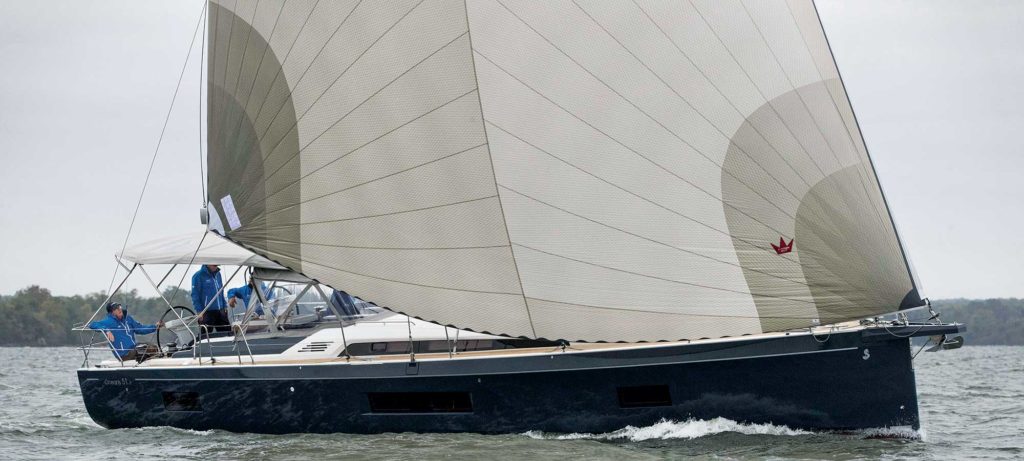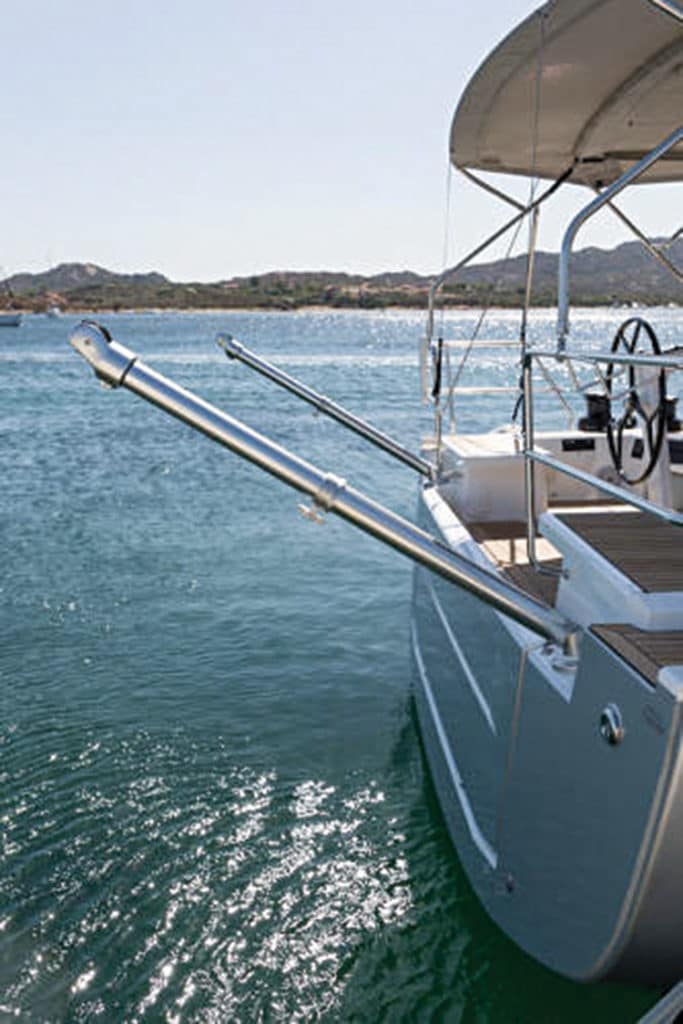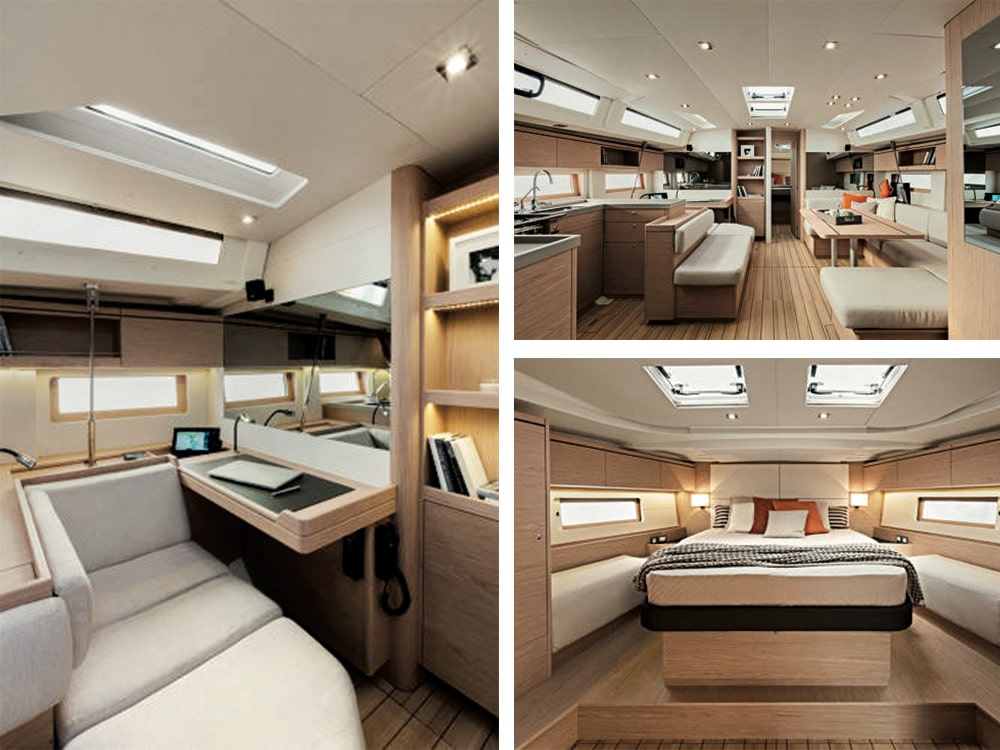
Inspiration is not always intuitive. The first model in the seventh (and latest) generation of Beneteau’s Oceanis cruising yachts, the new 51.1, owes its distinctive hull form not to the world of luxury sailboats but to an all-carbon, hard-chined rocket ship, the Juan Kouyoumdjian-designed Rambler 88. The result is a distinctive, and I think good-looking, change to a product line that’s now entering its third decade. But while Rambler in race mode is a stripped-out shell that requires a full squad of race-hardened deck apes to sail, the creature comforts abound on the 51.1, from its plumb bow to the push-button fold-down swim-platform transom, and by design, it’s a sailboat that’s meant to be cruised by a couple, with occasional friends and family. Several seasons ago, Beneteau reintroduced chines as a design element, originally in its First line of racer-cruisers, then in several Sense models and more recently in the Oceanis range. The hard-edge look, quickly adopted by a host of other builders, is credited with providing (in varying degrees, depending on whom you talk to) style, form stability and interior volume.
With the 51.1, Beneteau general manager Gianguido Girotti and the designers at Berret Racoupeau have taken the whole chines concept to an extreme — on the 51.1, they literally run from bow to stern — an idea, Girotti says, that came from observing the lines of Rambler, arguably one of the fastest boats in the world.

Retractable davits, which first appeared on boats in the Jeanneau brand, are now being used on Beneteaus. They solve the problem of where to store the dinghy on wide-transom boats with fold-down swim platforms. Courtesy of the manufacturer
In theory, carrying the chines the length of the hull allows for a fine entry, decreased wetted surface and greater buoyancy, which translates into a faster and more powerful hull form in the case of Rambler, and not by coincidence, more interior space for luxury living in the 51.1.
This is a big boat. The cockpit is the equivalent of what you might find on a 55-footer, says Girotti, and down below, well, just take note that in the forward cabin, besides the separate head and shower compartments and a pair of hanging lockers, the island queen berth has room to walk on either side of it and port and starboard nightstands and couches too!
Stepping aboard to have a look, the first question that came to mind was “How will this boat sail?” It turns out the 51.1 moves along quite well.
In a little more than 10 knots of breeze, the speed on the GPS read 7.4 knots upwind under main and 90 percent self-tacking jib. And it held that pace when we bore off to a reach and rolled out a code zero set on the boat’s composite bowsprit.
“Twin rudder, spins quite fast,” I jotted in my notes as I tacked the boat back and forth a couple of times without lifting even a finger to adjust either the main or jib sheets, both of which were led to winches near the twin wheels.
If I had to gripe about something, it would be the full bimini that covered the cockpit and made it difficult to see the sails, particularly the main. There’s an obvious solution, of course, which would be just to take it down.
The 51.1 comes standard with in-mast furling, the aforementioned self-tacking headsail and a 7-foot-7-inch iron keel. From there, there are options for a 105 percent genoa, code zero, asymmetric spinnaker, shoal keel (6 feet 1 inch) or a Performance package that adds about 5 feet to the standard 70-foot-1-inch mast and includes a deep iron keel (9 feet 2 inches) with a lead bulb.
Beneteau vacuum-infuses its hulls, which, like the decks, are balsa-cored. A layer of vinylester resin protects the hull from blistering. The boat can be ordered either with a German-style double-ended mainsheet system, as on the boat we sailed, or with a cockpit arch on which blocks for the mainsheet are mounted. I’d opt for the former, which gives you better control over sail shape.
For the record, a base boat sells for right around $600,000, but a long list of options — including up to five cabins and three heads, not to mention finishes, fabrics, teak decking, air conditioning and Dock & Go rotating saildrive package — can add considerably to the bill. The boat we sailed carried a price tag of $630,000. It was powered with the optional 110 hp Yanmar, with shaft drive. An 80 hp Yanmar and saildrive are standard.

Wide side decks on the 51.1 are appreciated when moving about. Lower stays are brought inside to the cabin top and outers attach to the hull, which means you don’t have to wiggle around either when heading forward. In the cockpit, there are large cushioned lounging areas to either side of the companionway that would make fine berths with the dodger up at night, or sun beds with it down during the day. I found the cockpit seats to be quite comfortable thanks to the cushioned coamings. They flank a sizable drop-leaf table that has a fridge beneath it forward and room for a life raft in a compartment aft.
Like other recent Beneteaus, the companionway below is more like a staircase, with good handrails to either side. The boat we sailed was fitted with two aft cabins, each with hanging lockers and their own head and shower.
A well-equipped galley is forward to port, followed by what the builder calls the “owners area” — essentially a combination nav station and desk with an interesting seat that morphs into an athwartships recliner. Opposite all of this is a gigantic table surrounded by U-shaped seating that, all told, will seat 14.
The boat shown last fall at the U.S. Sailboat Show in Annapolis, Maryland, had brushed-oak woodwork offset by white fabric-covered panels. Ports in the hull and cabin top let in loads of light, and overhead hatches promised good ventilation in the owners cabin and saloon.
Abovedecks and below, the 51.1 offers multiple spaces for enjoying days and nights on the water, which is right in line with all the other models in the time-tested Oceanis range.
Specifications
Beneteau 51.1
| LENGTH OVERALL | 52’4” (15.95 m) |
| WATERLINE LENGTH | 47’8” (14.53 m) |
| BEAM | 15’9” (4.8 m) |
| DRAFT | 7’7” (2.31 m) |
| SAIL AREA (100%) | 1,011 sq. ft. (93.9 sq. m) |
| BALLAST | 7,485 lb. 3,395 kg) |
| DISPLACEMENT | 30,702 lb. (13,926 kg) |
| BALLAST/DISPLACEMENT | 0.24 |
| DISPLACEMENT/LENGTH | 127 |
| SAIL AREA/DISPLACEMENT | 16.5 |
| WATER | 116 gal. (439 l) |
| FUEL | 53 gal. (201 l) |
| HOLDING (x3) | 21 gal. (79 l) |
| MAST HEIGHT | 70’1” (21.36 m) |
| ENGINE | 110 hp Yanmar, shaft drive |
| DESIGNER | Berret Racoupeau Yacht Design/Nauta Design |
| PRICE | $630,000 |
Beneteau
410-990-0270
beneteau.com
Sea Trial
| Wind speed 10 to 11 knots | |
| Sea state Some waves | |
| Sailing | |
| Closehauled: | 7.4 knots |
| Reaching: | 7.4 knots |
| Motoring | |
| Cruise (2,100 rpm) | 7.9 knots |
| Fast (2,800 rpm) | 8.6 knots |








